- Joined
- Feb 2, 2011
- Messages
- 2,379
THE ANCIENTS
ARMIES AND ENEMIES OF ANCIENT ROME
ROMAN AUXILLIARY CAVALRY
As Romans were never considered exceptionally good horsemen, and the role of the cavalry not as important in the Roman thought process, the Equitatus was generally made up of non-Roman horsemen. While they would play an important part of Legionary tactics, the Roman Cavalry was considered secondary and would remain the weakest part of the Roman Army until the very late Imperial period.
Generally, the cavalry was used as light skirmishing troops, and mounted archers whose job was to patrol, act as scouts and messengers and to provide a mobile defensive screen while the legion was massing in battle array. As in all armies throughout history, the mounted trooper was also very effective in chasing down and harassing a fleeing and panicked enemy force.
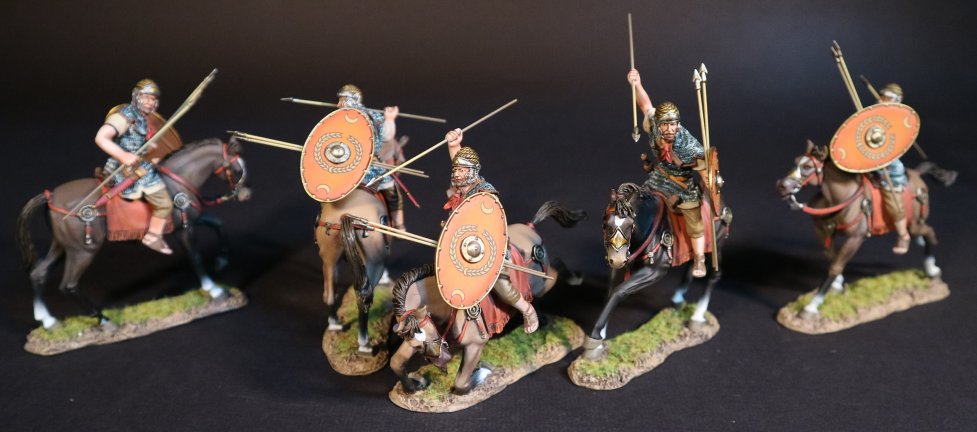
As part of the military reforms of Augustus around AD 14, the Auxilia were re-organized. They would be trained to the same standards of discipline as the legions. They were mainly drawn from a wide range of warlike peoples throughout the provinces, and would receive Roman citizenship on completion of their 25 year service. Senior officers in contrast were Roman citizens.
The Auxilia filled the tasks of patrolling, containing raids, tax collecting, and the multitude of duties of the frontier troops.
They were especially suited to garrison and local policing activities, and could also hold their own in small scale warfare.
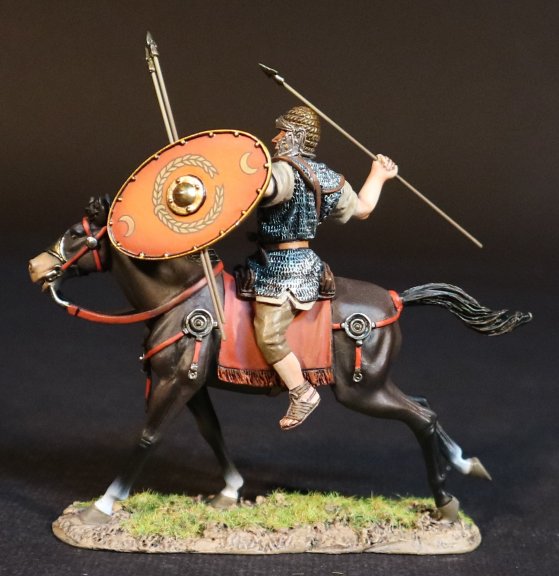
ROMCAV-16A
ARMIES AND ENEMIES OF ANCIENT ROME,
ROMAN AUXILIARY CAVALRY
Roman Auxilia cavalry were usually heavily armored in mail and armed with a short lance, javelins, the Spatha long sword, and sometimes bows for specialist Horse archer units. These men primarily served as Medium missile cavalry for flanking, scouting, skirmish, and pursuit.
Cavalry units were known as Alae, and were made up of 16 Turmae.
A Turmae consisted of 30 troopers, and was commanded by a Decurio, and a second in command called the Duplicarius.
Cavalrymen carried Clipeus , a flat oval or hexagonal shield. These were extremely light, constructed of double or triple thickness plywood, made up of thin strips of birch.
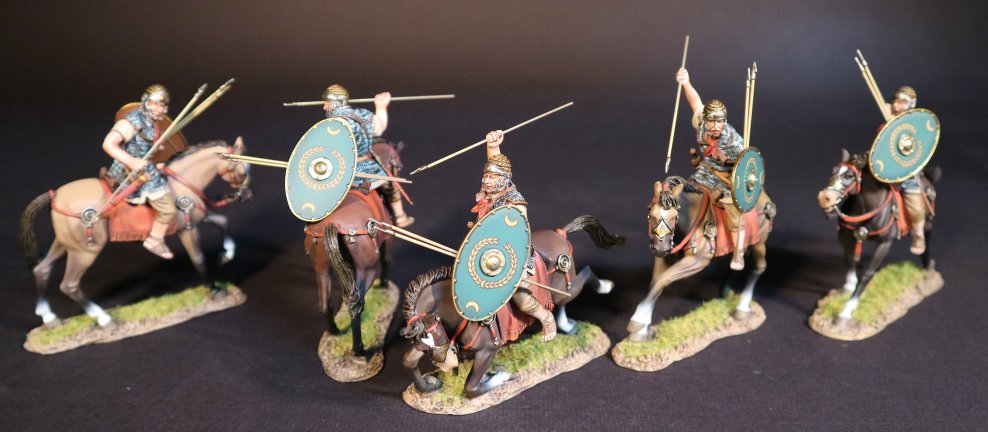
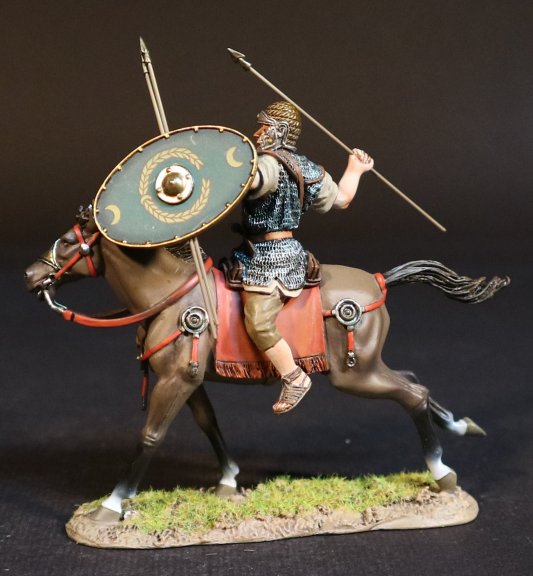
ROMCAV-16B
ARMIES AND ENEMIES OF ANCIENT ROME,
ROMAN AUXILIARY CAVALRY
ARMIES AND ENEMIES OF GREECE AND MACEDONIA
THE ACHAEMENID PERSIAN ARMY
PERSIAN HEAVY CAVALRY
The Achaemenid Empire c. 550–330 BC, also called the First Persian Empire, was an ancient Iranian empire based in Western Asia founded by Cyrus the Great. Ranging at its greatest extent from the Balkans in the west to the Indus Valley in the east, it was larger than any previous empire in history, spanning 5.5 (or 8) million square kilometers. Incorporating various peoples of different origins and faiths, it is notable for its successful model of a centralised, bureaucratic administration (through satraps under the King of Kings), for building infrastructure such as road systems and a postal system, the use of an official language across its territories, and the development of civil services and a large professional army. The empire's successes inspired similar systems in later empires
The Achaemenid Empire encompassed a vast and diverse range of territories, from Anatolia and Egypt to the Indus Valley. This diversity was reflected in its cavalry, which included units from various ethnic groups such as Medes, Persians, Bactrians, Scythians, and Sakas.
Each group brought its own unique style of cavalry warfare, contributing to the overall effectiveness of the Achaemenid cavalry.
CYRUS THE YOUNGERS’ BODYGUARD
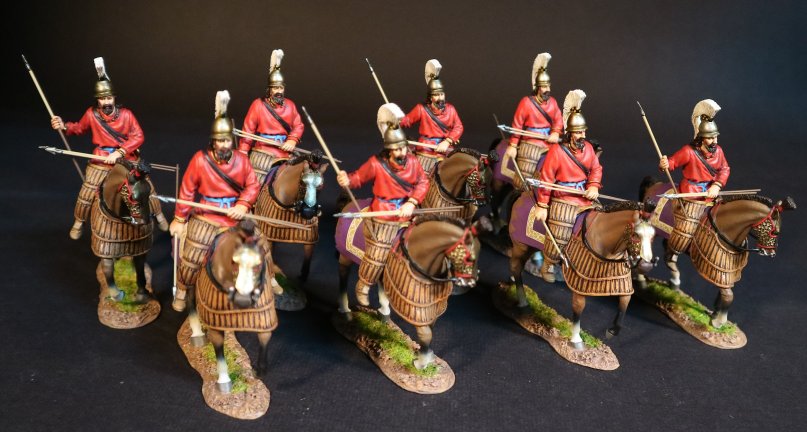
Based on Xenophon’s descriptions of Cyrus’ bodyguard at the Battle of Kounaxa in 401BC, they are described as having a cuirass under the red tunic, and a bronze helmet. The general appearance of recent illustrations are inspired by a relief in Turkey, which shows a Persian cavalryman with a crested pilos helmet fighting a Greek Hoplite.
Another part of the relief shows bronze horse’s head-armour, and horse’s breast armour of embossed bronze or leather.
It has also been described that the guard wore matching thigh and leg guards.
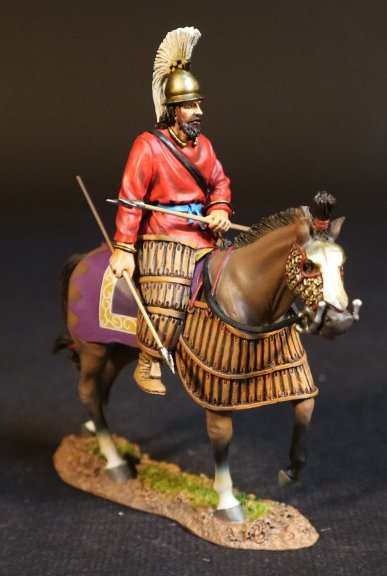
AP-61
ARMIES AND ENEMIES OF GREECE AND MACEDONIA,
THE ACHAEMENID PERSIAN EMPIRE,
PERSIAN HEAVY CAVALRY,
CYRUS THE YOUNGERS’ BODYGUARD
CRETAN ARCHERS
Cretan archers were a well known class of warrior whose specialist skills were extensively utilized by many ancient armies. They were especially valued in armies such as those of the Greek city states, notably Athens, Sparta and later Macedonia, as well as Rome as these armies could not draw upon substantial numbers of skilled archers from their native populations.

Cretan archers carried a composite bow, which consisted of a wooden core with laminated layers of sinew and horn. These bows while difficult to string and use, they gave the professional Cretan archers greater range over the simple wooden bows of the citizen levies of other armies.
Cretan archers were widely recognized as being amongst the best light missile troops in the ancient world, and as such found employment as mercenaries in many armies, including the armies of Alexander the Great.
Eurybotas was the toxarch, meaning the captain of the archers employed by Alexander.
During the retreat of the ten thousand following the Battle of Cunexa in 401 BC, Xenophon’s hoplites were able to hold off pursuing Persian troops, with the aid of the Cretan archers who formed part of the Greek mercenary army.
On this occasion the Cretans, cut off from supplies, were able to gather and reuse the spent Persian arrows while seizing bowstrings from local peasantry.
Following the conquest of Macedonia and the independent Greek city-states, Cretan archers served as auxiliaries in the Roman army, as reformed by Gaius Marius under the Republic, and later that of the Empire.
They were armed with secondary weapons for use at close quarters, included a sword and small round shields. This undoubtedly gave the Cretan warriors a huge advantage in skirmishing with other light troops.
Crete remained part of the Byzantine Empire until seized by Venice in the aftermath of the Fourth Crusade. During much of this period the island was a Theme (military province), providing both archers and sailors for the Byzantine forces.
In 1452 Venice granted specific permission for Byzantium to resume recruitment of Cretans. One of the last occasions on which Cretan archers are known to have played a significant role was as part of the garrison defending Constantinople against the Turkish army of Mehmet II in May 1453.
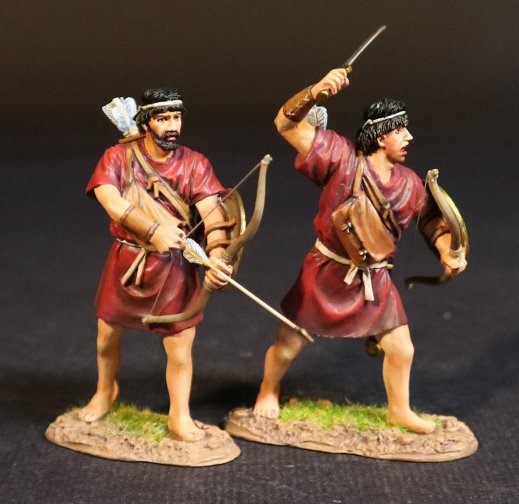
CRET-02A
ARMIES AND ENEMIES OF ANCIENT GREECE AND MACEDONIA,
CRETAN ARCHERS
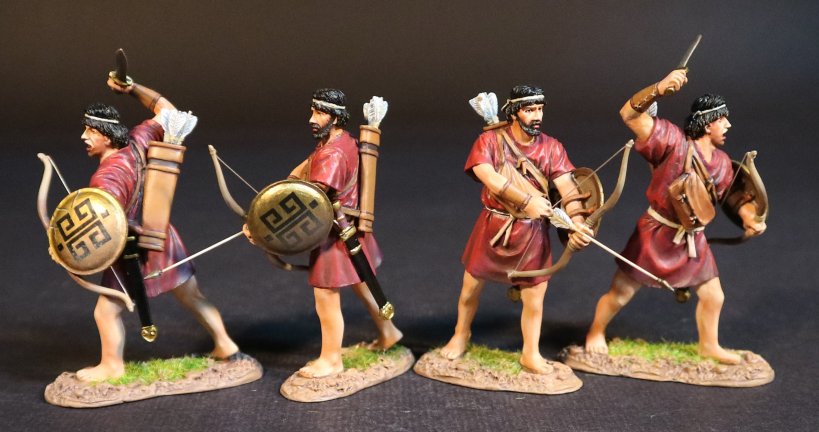
CRET-02AN
ARMIES AND ENEMIES OF ANCIENT GREECE AND MACEDONIA,
CRETAN ARCHERS
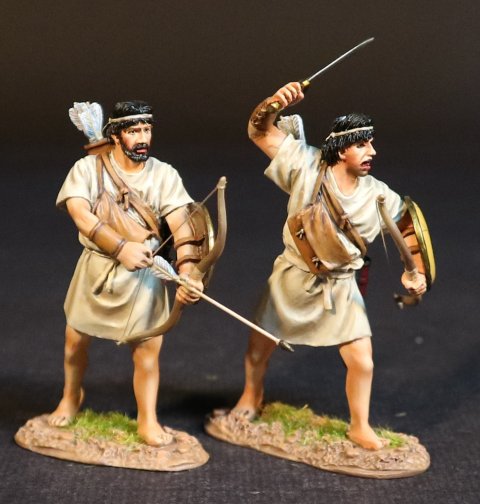
CRET-02B
ARMIES AND ENEMIES OF ANCIENT GREECE AND MACEDONIA,
CRETAN ARCHERS
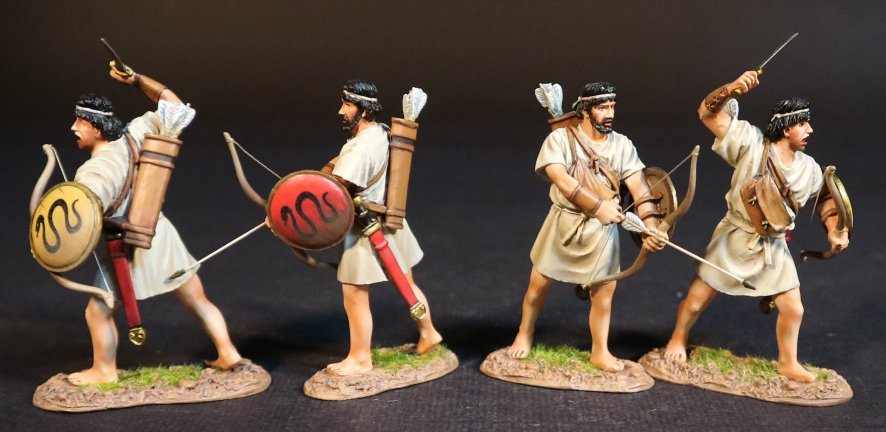
CRET-02BN
ARMIES AND ENEMIES OF ANCIENT GREECE AND MACEDONIA,
CRETAN ARCHERS
GLADIATORS
"HAIL, EMPEROR, THOSE WHO ARE ABOUT TO DIE SALUTE YOU."
Gladiators were armed combatants who entertained audiences in the Roman Republic and Roman Empire in violent confrontations with other gladiators, wild animals and condemned criminals.
Some gladiators were volunteers who risked their lives and their legal and social standing by appearing in the arena, but most were despised as slaves, schooled under harsh conditions, socially marginalized and even segregated even in death.

Irrespective of their origin, gladiators offered spectators an example of Rome’s martial ethics and in fighting or dying well, they could inspire admiration and popular acclaim.
They were celebrated in high and low art, and their value as entertainers was commemorated in precious and commonplace objects throughout the Roman world.
THE RETIARIUS
The retiarius gladiator was one of the most recognizable fighters of the ancient Roman Colosseum. The name Retiarius translates in latin as “net fighter”, and this gladiator did indeed fight with a net and a trident. The retiarii was in fact based on the role of the fisherman. In ancient Rome fishing played a large part of daily life, and the retiarius character was something that most common folk could support.
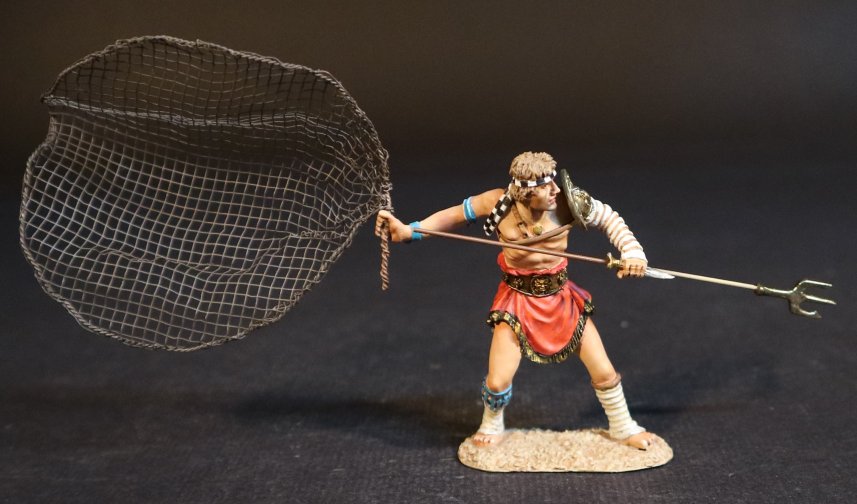
GLAD-03
GLADIATORS
"HAIL, EMPEROR, THOSE WHO ARE ABOUT TO DIE SALUTE YOU."
RETIARIUS
The retiarius were armed with the unique weapons, such as a trident and a net. These weapons obviously dictated their fighting style. The length of the trident meant the retiarii had to keep his distance, mainly jabbing and prodding from long range. Their light armour allowed them to move quickly, and as they wore no helmet their vision was clear and allowed for head movement in the way other gladiators could not.
The retiarius were able to use their net in multiple ways, trapping the other gladiator, trying to hook the net over a limb or head, or trap a weapon, pulling and releasing it from his foes grasp. Once successful and able to close with his opponent a small dagger could be used to quickly end his enemy.
The retiarii main opponent was the Secutor, although it is also believed that this gladiator also fought the Murmillo on occasion as well.
THE SECUTOR
A Secutor was a class of gladiator in ancient Rome. Thought to have originated around 50AD, the Secutor (“follower” or “Chaser”, from the Sequor, “I follow, come or go after”) was armed in a similar way to the Murmillo gladiator. Both were protected by a heavy shield, and carried a short sword or a dagger.
The Secutor was especially trained to fight a retiarius.
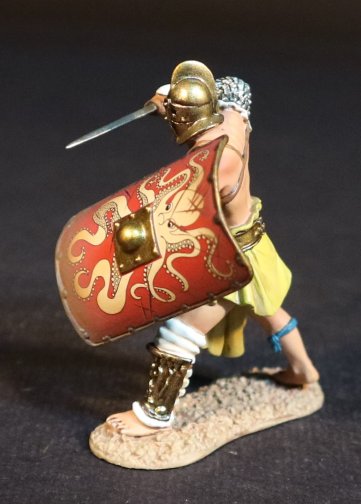
GLAD-04
GLADIATORS
"HAIL, EMPEROR, THOSE WHO ARE ABOUT TO DIE SALUTE YOU."
SECUTOR
The very distinctive helmet of the secutor had only two small eye-holes, in order to prevent a retiarius' trident from being thrust through the face, as well as a rounded top, so as not to get caught in a net.
The flanges protecting his neck were smooth and shaped like fish fins for this purpose. Because of the weight and lack of space in the helmet, the secutor had to win quickly, lest he fall to exhaustion or faint due to breathing constrictions and heavy armor.
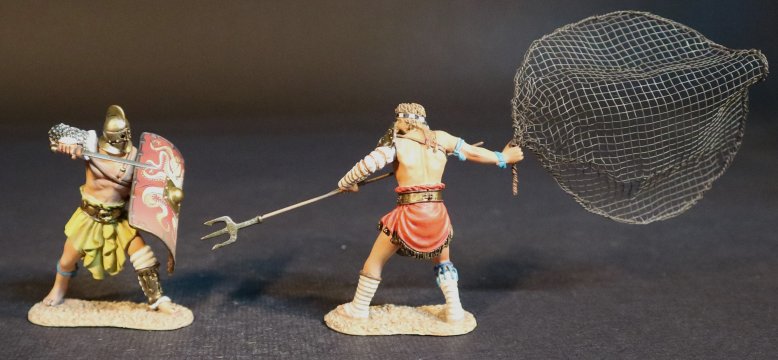
**PLEASE CONTACT YOUR LOCAL DEALER TO PLACE YOUR PRE-ORDERS**
ARMIES AND ENEMIES OF ANCIENT ROME
ROMAN AUXILLIARY CAVALRY
As Romans were never considered exceptionally good horsemen, and the role of the cavalry not as important in the Roman thought process, the Equitatus was generally made up of non-Roman horsemen. While they would play an important part of Legionary tactics, the Roman Cavalry was considered secondary and would remain the weakest part of the Roman Army until the very late Imperial period.
Generally, the cavalry was used as light skirmishing troops, and mounted archers whose job was to patrol, act as scouts and messengers and to provide a mobile defensive screen while the legion was massing in battle array. As in all armies throughout history, the mounted trooper was also very effective in chasing down and harassing a fleeing and panicked enemy force.

As part of the military reforms of Augustus around AD 14, the Auxilia were re-organized. They would be trained to the same standards of discipline as the legions. They were mainly drawn from a wide range of warlike peoples throughout the provinces, and would receive Roman citizenship on completion of their 25 year service. Senior officers in contrast were Roman citizens.
The Auxilia filled the tasks of patrolling, containing raids, tax collecting, and the multitude of duties of the frontier troops.
They were especially suited to garrison and local policing activities, and could also hold their own in small scale warfare.

ROMCAV-16A
ARMIES AND ENEMIES OF ANCIENT ROME,
ROMAN AUXILIARY CAVALRY
Roman Auxilia cavalry were usually heavily armored in mail and armed with a short lance, javelins, the Spatha long sword, and sometimes bows for specialist Horse archer units. These men primarily served as Medium missile cavalry for flanking, scouting, skirmish, and pursuit.
Cavalry units were known as Alae, and were made up of 16 Turmae.
A Turmae consisted of 30 troopers, and was commanded by a Decurio, and a second in command called the Duplicarius.
Cavalrymen carried Clipeus , a flat oval or hexagonal shield. These were extremely light, constructed of double or triple thickness plywood, made up of thin strips of birch.


ROMCAV-16B
ARMIES AND ENEMIES OF ANCIENT ROME,
ROMAN AUXILIARY CAVALRY
ARMIES AND ENEMIES OF GREECE AND MACEDONIA
THE ACHAEMENID PERSIAN ARMY
PERSIAN HEAVY CAVALRY
The Achaemenid Empire c. 550–330 BC, also called the First Persian Empire, was an ancient Iranian empire based in Western Asia founded by Cyrus the Great. Ranging at its greatest extent from the Balkans in the west to the Indus Valley in the east, it was larger than any previous empire in history, spanning 5.5 (or 8) million square kilometers. Incorporating various peoples of different origins and faiths, it is notable for its successful model of a centralised, bureaucratic administration (through satraps under the King of Kings), for building infrastructure such as road systems and a postal system, the use of an official language across its territories, and the development of civil services and a large professional army. The empire's successes inspired similar systems in later empires
The Achaemenid Empire encompassed a vast and diverse range of territories, from Anatolia and Egypt to the Indus Valley. This diversity was reflected in its cavalry, which included units from various ethnic groups such as Medes, Persians, Bactrians, Scythians, and Sakas.
Each group brought its own unique style of cavalry warfare, contributing to the overall effectiveness of the Achaemenid cavalry.
CYRUS THE YOUNGERS’ BODYGUARD

Based on Xenophon’s descriptions of Cyrus’ bodyguard at the Battle of Kounaxa in 401BC, they are described as having a cuirass under the red tunic, and a bronze helmet. The general appearance of recent illustrations are inspired by a relief in Turkey, which shows a Persian cavalryman with a crested pilos helmet fighting a Greek Hoplite.
Another part of the relief shows bronze horse’s head-armour, and horse’s breast armour of embossed bronze or leather.
It has also been described that the guard wore matching thigh and leg guards.

AP-61
ARMIES AND ENEMIES OF GREECE AND MACEDONIA,
THE ACHAEMENID PERSIAN EMPIRE,
PERSIAN HEAVY CAVALRY,
CYRUS THE YOUNGERS’ BODYGUARD
CRETAN ARCHERS
Cretan archers were a well known class of warrior whose specialist skills were extensively utilized by many ancient armies. They were especially valued in armies such as those of the Greek city states, notably Athens, Sparta and later Macedonia, as well as Rome as these armies could not draw upon substantial numbers of skilled archers from their native populations.

Cretan archers carried a composite bow, which consisted of a wooden core with laminated layers of sinew and horn. These bows while difficult to string and use, they gave the professional Cretan archers greater range over the simple wooden bows of the citizen levies of other armies.
Cretan archers were widely recognized as being amongst the best light missile troops in the ancient world, and as such found employment as mercenaries in many armies, including the armies of Alexander the Great.
Eurybotas was the toxarch, meaning the captain of the archers employed by Alexander.
During the retreat of the ten thousand following the Battle of Cunexa in 401 BC, Xenophon’s hoplites were able to hold off pursuing Persian troops, with the aid of the Cretan archers who formed part of the Greek mercenary army.
On this occasion the Cretans, cut off from supplies, were able to gather and reuse the spent Persian arrows while seizing bowstrings from local peasantry.
Following the conquest of Macedonia and the independent Greek city-states, Cretan archers served as auxiliaries in the Roman army, as reformed by Gaius Marius under the Republic, and later that of the Empire.
They were armed with secondary weapons for use at close quarters, included a sword and small round shields. This undoubtedly gave the Cretan warriors a huge advantage in skirmishing with other light troops.
Crete remained part of the Byzantine Empire until seized by Venice in the aftermath of the Fourth Crusade. During much of this period the island was a Theme (military province), providing both archers and sailors for the Byzantine forces.
In 1452 Venice granted specific permission for Byzantium to resume recruitment of Cretans. One of the last occasions on which Cretan archers are known to have played a significant role was as part of the garrison defending Constantinople against the Turkish army of Mehmet II in May 1453.

CRET-02A
ARMIES AND ENEMIES OF ANCIENT GREECE AND MACEDONIA,
CRETAN ARCHERS

CRET-02AN
ARMIES AND ENEMIES OF ANCIENT GREECE AND MACEDONIA,
CRETAN ARCHERS

CRET-02B
ARMIES AND ENEMIES OF ANCIENT GREECE AND MACEDONIA,
CRETAN ARCHERS

CRET-02BN
ARMIES AND ENEMIES OF ANCIENT GREECE AND MACEDONIA,
CRETAN ARCHERS
GLADIATORS
"HAIL, EMPEROR, THOSE WHO ARE ABOUT TO DIE SALUTE YOU."
Gladiators were armed combatants who entertained audiences in the Roman Republic and Roman Empire in violent confrontations with other gladiators, wild animals and condemned criminals.
Some gladiators were volunteers who risked their lives and their legal and social standing by appearing in the arena, but most were despised as slaves, schooled under harsh conditions, socially marginalized and even segregated even in death.

Irrespective of their origin, gladiators offered spectators an example of Rome’s martial ethics and in fighting or dying well, they could inspire admiration and popular acclaim.
They were celebrated in high and low art, and their value as entertainers was commemorated in precious and commonplace objects throughout the Roman world.
THE RETIARIUS
The retiarius gladiator was one of the most recognizable fighters of the ancient Roman Colosseum. The name Retiarius translates in latin as “net fighter”, and this gladiator did indeed fight with a net and a trident. The retiarii was in fact based on the role of the fisherman. In ancient Rome fishing played a large part of daily life, and the retiarius character was something that most common folk could support.

GLAD-03
GLADIATORS
"HAIL, EMPEROR, THOSE WHO ARE ABOUT TO DIE SALUTE YOU."
RETIARIUS
The retiarius were armed with the unique weapons, such as a trident and a net. These weapons obviously dictated their fighting style. The length of the trident meant the retiarii had to keep his distance, mainly jabbing and prodding from long range. Their light armour allowed them to move quickly, and as they wore no helmet their vision was clear and allowed for head movement in the way other gladiators could not.
The retiarius were able to use their net in multiple ways, trapping the other gladiator, trying to hook the net over a limb or head, or trap a weapon, pulling and releasing it from his foes grasp. Once successful and able to close with his opponent a small dagger could be used to quickly end his enemy.
The retiarii main opponent was the Secutor, although it is also believed that this gladiator also fought the Murmillo on occasion as well.
THE SECUTOR
A Secutor was a class of gladiator in ancient Rome. Thought to have originated around 50AD, the Secutor (“follower” or “Chaser”, from the Sequor, “I follow, come or go after”) was armed in a similar way to the Murmillo gladiator. Both were protected by a heavy shield, and carried a short sword or a dagger.
The Secutor was especially trained to fight a retiarius.

GLAD-04
GLADIATORS
"HAIL, EMPEROR, THOSE WHO ARE ABOUT TO DIE SALUTE YOU."
SECUTOR
The very distinctive helmet of the secutor had only two small eye-holes, in order to prevent a retiarius' trident from being thrust through the face, as well as a rounded top, so as not to get caught in a net.
The flanges protecting his neck were smooth and shaped like fish fins for this purpose. Because of the weight and lack of space in the helmet, the secutor had to win quickly, lest he fall to exhaustion or faint due to breathing constrictions and heavy armor.

**PLEASE CONTACT YOUR LOCAL DEALER TO PLACE YOUR PRE-ORDERS**

